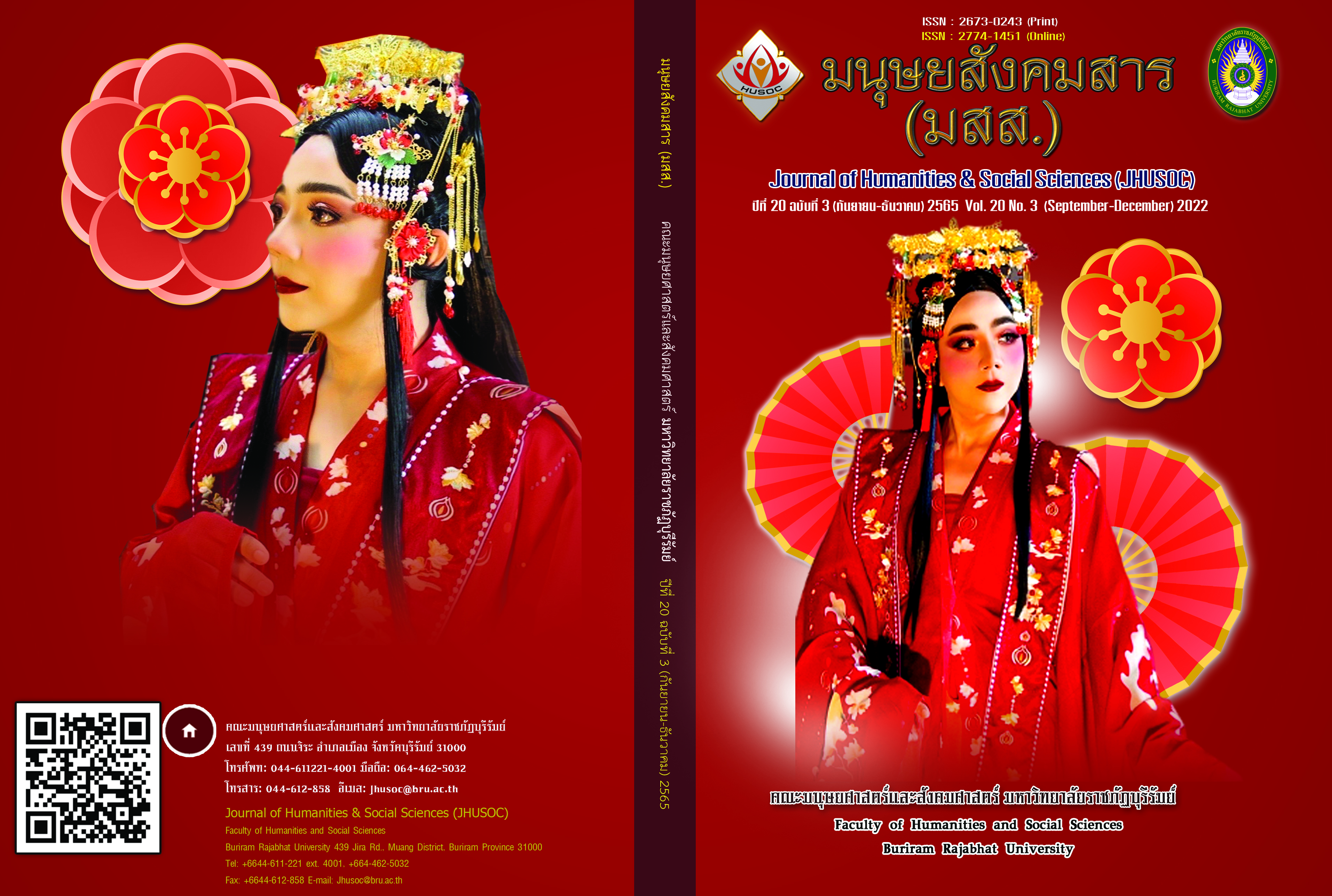Mobile Learning in English Listening and Speaking Skills: Challenges and Opportunities of Non-English Major Sophomores at a Public University in China
Main Article Content
บทคัดย่อ
The rapid development of technology and the need to acquire English listening and speaking skills in China have brought opportunities and challenges to Chinese university students. This study thus used explanatory sequential mixed methods to investigate opportunities and challenges in mobile learning in English listening and speaking skills. Data collected from 344 non-English major sophomores at a public university in Yunnan, China, were randomly recruited to complete a questionnaire, followed by semi-structured interviews with 10 of them. The results indicated that mobile learning was deemed more supported than rejected by the students who found it easy to use, useful, resourceful and manageable in self-learning, so it brought them more opportunities to learn those two English skills actively and independently at anytime and anywhere easily than challenges demotivating them to learn the language. Such opportunities partly fulfilled the objectives of the Chinese government’s Education Informatization 2.0 Action Plan released in 2018. The learning purposes also reflected their extrinsic and intrinsic motivation, which was the driving force for opportunities to learn those two English skills.
Article Details

อนุญาตภายใต้เงื่อนไข Creative Commons Attribution-NonCommercial 4.0 International License.
เนื้อหาและข้อมูลในบทความที่ลงตีพิมพ์ในวารสารทดสอบระบบ ThaiJo2 ถือเป็นข้อคิดเห็นและความรับผิดชอบของผู้เขียนบทความโดยตรงซึ่งกองบรรณาธิการวารสาร ไม่จำเป็นต้องเห็นด้วย หรือร่วมรับผิดชอบใดๆ
บทความ ข้อมูล เนื้อหา รูปภาพ ฯลฯ ที่ได้รับการตีพิมพ์ในวารสารทดสอบระบบ ThaiJo2 ถือเป็นลิขสิทธิ์ของวารสารทดสอบระบบ ThaiJo2 หากบุคคลหรือหน่วยงานใดต้องการนำทั้งหมดหรือส่วนหนึ่งส่วนใดไปเผยแพร่ต่อหรือเพื่อกระทำการใดๆ จะต้องได้รับอนุญาตเป็นลายลักอักษรจากวารสารทดสอบระบบ ThaiJo2 ก่อนเท่านั้น
เอกสารอ้างอิง
Alhajri, R. A. (2016). Prospects and challenges of mobile learning implementation: A case study. Journal of Information Technology & Software Engineering, 6(5), 1-8. doi: https://doi.org/10.4172/2165-7866.1000189
Carlson, R., & Turner, R. (2013). Review of agile case studies for applicability to aircraft systems integration. Procedia Computer Science, 16(1), 469-474. https://doi.org/10.1016/j.procs.2013.01.049
Chen, C. (2020). A study on the current situation of public English speaking teaching in universities and its teaching methods, Overseas English, 39(12), 5-8.
Dong, H. L. (2002). A comparison of university English teaching models between Fudan University and Yunnan University. Yunnan Education, 12(30), 70-74.
Fang, L. (2018). Current situation: Problems and embedding path of "online teaching" in universities. Market Research, 18(12), 15-17.
Guo, H. (2018). Thoughts on the reform of teaching methods in universities under the background of “Internet+”. Chinese Journal of Adult Education, 17(23), 23-25.
He, C. J. (2020). An empirical analysis of higher vocational students' attitudes towards learning English based on smartphones, Journal of Qingyuan Vocational and Technical University, 13(2), 56-59.
Hu, L. J. (2020). Research on university oral English teaching practice under the background of artificial intelligence. Journal of Jiangxi Electric Power Vocational and Technical University, 33(9), 31-38.
Ibrahim, E. I. M. (2019). Mobile learning for English language learning: benefits and challenges. European Journal of Open Education and E-learning Studies, 1(4), 44-58. doi:http://dx.doi.org/10.46827/ejoe.v0i0.2290
Johnson, R. B., & Larry, C. (2016). Educational research: quantitative, qualitative, and mixed approaches. SAGE.
Kothari C. R. (2004) Research methodology: Method and techniques. New Age International.
Li, S. Y. (2016). An empirical study on the effectiveness of mobile technology assisted foreign language teaching in English vocabulary acquisition. Foreign Languages, 5(4), 73-81.
Lin, C. L. (2020). Application and research hot spot of Artificial intelligence in foreign language. Teaching Education Informatization in China, 20(6), 29-32.
Liu, L. (2018). A study on extra-curricular learning strategies of university English courses for non-English majors. Cultural Education, 18(4), 221-225.
Liu, X. Y. (2010). History of Yunnan University series. Yunnan University Press.
Ma, Y. T. (2019). Analysis and discussion on university students’ oral English learning skills. English for Campus, 36(29), 9-10.
Meng, J. J., Zhang, H. Y., Zhou, Y., & Yang, J. J. (2017). Investigation and analysis of the Influence of “micro-era” on university students’ academic performance. Journal of Corps Education University, 27(5), 42-49.
Min, S. C. (2018). Current situation and development trend of oral English research in China. Chinese Foreign Languages, 7(6), 85-91.
Pang, Y. B. (2017). Research on university students’ mobile learning ability. Journal of Heilongjiang University of Education, 36(11), 10-12.
Qiu, J. (2019). Current situation and teaching strategies of university oral English teaching. Journal of Jilin Institute of Education, 35(5), 87-90.
Rong, X. L. (2018). Misunderstandings in oral English learning and countermeasures. Journal of Guizhou University, 26(4), 24-27.
Seonghoon, K. (2015). Cronbach’s coefficient alpha: Well-known but poorly understood. Organizational Research Methods, 18(2), 207-230.doi: http://dx.doi.org/10.1177/1094428114555994
Song, M. Y., Guo, J., Zhai, X. M., & Zhang, Y. R. (2021). Current status and influencing factors of mobile learning in university students. Health Vocational Education, 23(39), 134-135.
Wang, Q., Wu, H., Zhou, X. R., Li, X., Zhang, Y., & Wang, W. (2020). Research and practice of classroom teaching mode based on mobile devices. Science and Technology Vision, 36(29), 75-78.
Wu, G. (2019) Analysis of challenges of university students' mobile learning: A case study of Nanjing University of posts and telecommunications. University of Posts and Telecommunications Press.
Xin, H. (2019). Research on mobile learning in higher vocational universities based on mobile phone. Overseas English, 19(10), 31-33.
Xue, S. M. (2018). The application of blended teaching mode in English audio-visual speaking courses in universities. University English, 18(30), 49-50.
Yu, X. (2020). A review of university English teaching model under the background of educational informatization. Journal of Shangluo University, 35(5), 87-92.
Yuan, Y. (2020). Investigation on mobile learning in English at Heilongjiang university. Harbin Normal University Press.
Zhang, J. (2019). Research on mobile devices for students’ English learning especially independent reading. Journal of HuBei Open Vocational University, 11(32), 167-168.
Zhang, X. D. (2017). Research on College English mobile learning model in the era of “Internet +”. Journal of Shenyang Jianzhu University, 19(2), 194-199.
Zheng, J. (2018). Investigation and analysis of the current situation of hybrid teaching in Chinese Universities. Heilongjiang Higher Education Research, 69(12), 44-48.
Zhou, J. L. (2015). Analysis of phrases characteristics of CET-4 and CET-6 from the perspective of university English teaching requirements. Journal of Zhaoqing University, 76(12), 25-26.
Zou, B., & Yan, X. (2016). Chinese students’ perceptions of using mobile devices for English learning. International Journal of Computer-Assisted Language Learning and Teaching, 4(3), 20-33.


